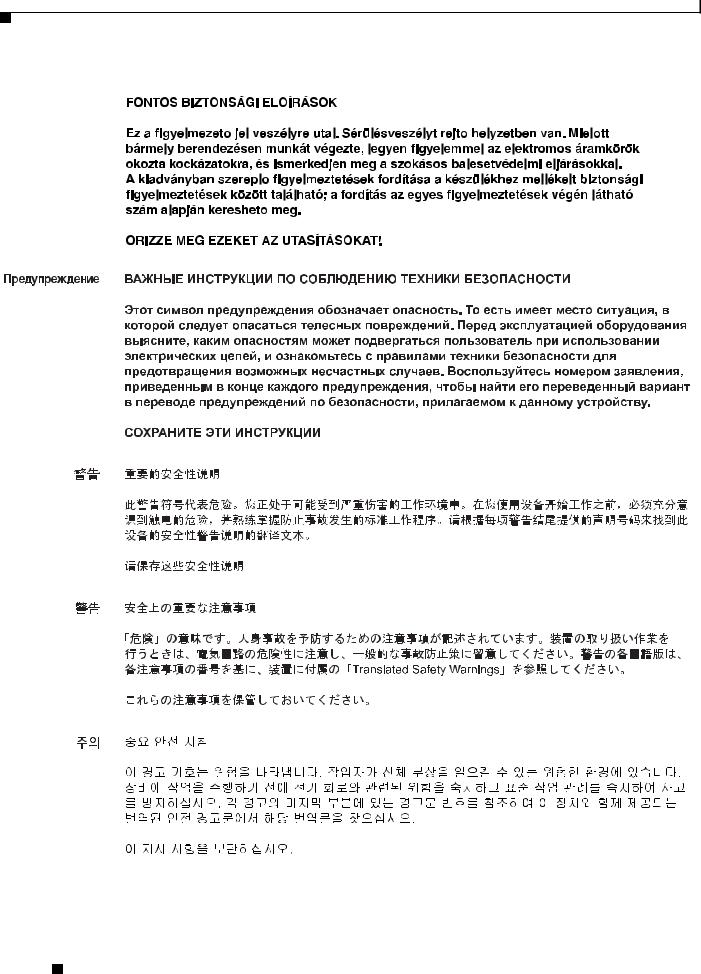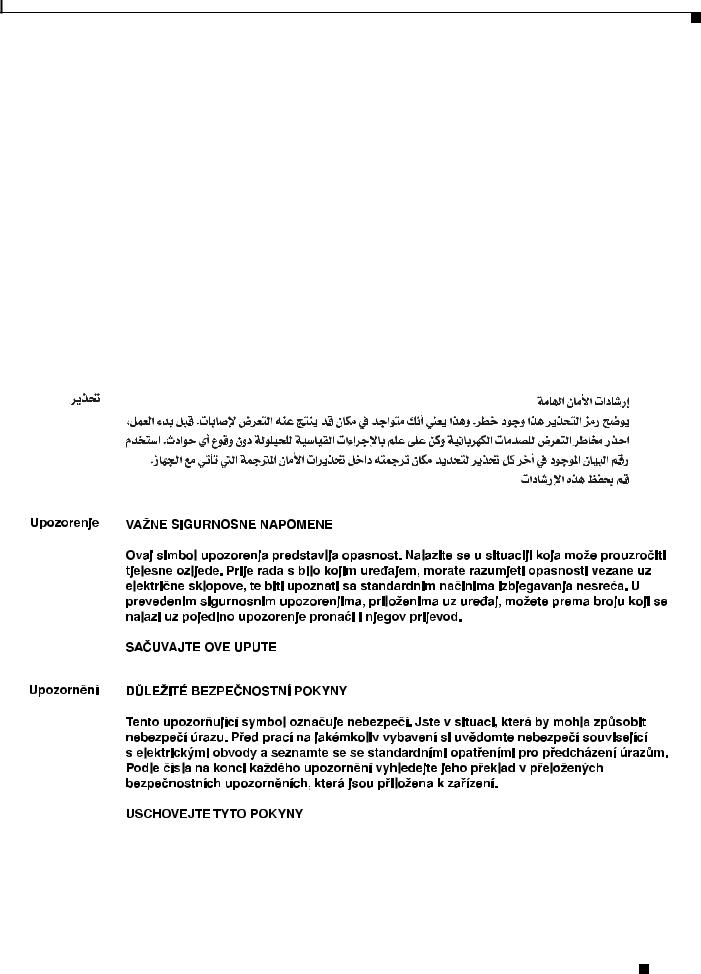Cisco ONS 15310-MA, ONS 15310-CL User Manual

Cisco ONS 15310-CL,
Cisco ONS 15310-MA, and
Cisco ONS 15310-MA SDH Ethernet Card
Software Feature and Configuration Guide
Cisco IOS Release 12.2(29)SVE0, 12.2(33)STE0
CTC and Documentation Release 9.1 and Release 9.2
August 2012
Americas Headquarters
Cisco Systems, Inc. 170 West Tasman Drive
San Jose, CA 95134-1706 USA http://www.cisco.com Tel: 408 526-4000
800 553-NETS (6387) Fax: 408 527-0883
Text Part Number: 78-19415-01
THE SPECIFICATIONS AND INFORMATION REGARDING THE PRODUCTS IN THIS MANUAL ARE SUBJECT TO CHANGE WITHOUT NOTICE. ALL STATEMENTS, INFORMATION, AND RECOMMENDATIONS IN THIS MANUAL ARE BELIEVED TO BE ACCURATE BUT ARE PRESENTED WITHOUT WARRANTY OF ANY KIND, EXPRESS OR IMPLIED. USERS MUST TAKE FULL RESPONSIBILITY FOR THEIR APPLICATION OF ANY PRODUCTS.
THE SOFTWARE LICENSE AND LIMITED WARRANTY FOR THE ACCOMPANYING PRODUCT ARE SET FORTH IN THE INFORMATION PACKET THAT SHIPPED WITH THE PRODUCT AND ARE INCORPORATED HEREIN BY THIS REFERENCE. IF YOU ARE UNABLE TO LOCATE THE SOFTWARE LICENSE OR LIMITED WARRANTY, CONTACT YOUR CISCO REPRESENTATIVE FOR A COPY.
The following information is for FCC compliance of Class A devices: This equipment has been tested and found to comply with the limits for a Class A digital device, pursuant to part 15 of the FCC rules. These limits are designed to provide reasonable protection against harmful interference when the equipment is operated in a commercial environment. This equipment generates, uses, and can radiate radio-frequency energy and, if not installed and used in accordance with the instruction manual, may cause harmful interference to radio communications. Operation of this equipment in a residential area is likely to cause harmful interference, in which case users will be required to correct the interference at their own expense.
The following information is for FCC compliance of Class B devices: The equipment described in this manual generates and may radiate radio-frequency energy. If it is not installed in accordance with Cisco’s installation instructions, it may cause interference with radio and television reception. This equipment has been tested and found to comply with the limits for a Class B digital device in accordance with the specifications in part 15 of the FCC rules. These specifications are designed to provide reasonable protection against such interference in a residential installation. However, there is no guarantee that interference will not occur in a particular installation.
Modifying the equipment without Cisco’s written authorization may result in the equipment no longer complying with FCC requirements for Class A or Class B digital devices. In that event, your right to use the equipment may be limited by FCC regulations, and you may be required to correct any interference to radio or television communications at your own expense.
You can determine whether your equipment is causing interference by turning it off. If the interference stops, it was probably caused by the Cisco equipment or one of its peripheral devices. If the equipment causes interference to radio or television reception, try to correct the interference by using one or more of the following measures:
•Turn the television or radio antenna until the interference stops.
•Move the equipment to one side or the other of the television or radio.
•Move the equipment farther away from the television or radio.
•Plug the equipment into an outlet that is on a different circuit from the television or radio. (That is, make certain the equipment and the television or radio are on circuits controlled by different circuit breakers or fuses.)
Modifications to this product not authorized by Cisco Systems, Inc. could void the FCC approval and negate your authority to operate the product.
The Cisco implementation of TCP header compression is an adaptation of a program developed by the University of California, Berkeley (UCB) as part of UCB’s public domain version of the UNIX operating system. All rights reserved. Copyright © 1981, Regents of the University of California.
NOTWITHSTANDING ANY OTHER WARRANTY HEREIN, ALL DOCUMENT FILES AND SOFTWARE OF THESE SUPPLIERS ARE PROVIDED “AS IS” WITH ALL FAULTS. CISCO AND THE ABOVE-NAMED SUPPLIERS DISCLAIM ALL WARRANTIES, EXPRESSED OR IMPLIED, INCLUDING, WITHOUT LIMITATION, THOSE OF MERCHANTABILITY, FITNESS FOR A PARTICULAR PURPOSE AND NONINFRINGEMENT OR ARISING FROM A COURSE OF DEALING, USAGE, OR TRADE PRACTICE.
IN NO EVENT SHALL CISCO OR ITS SUPPLIERS BE LIABLE FOR ANY INDIRECT, SPECIAL, CONSEQUENTIAL, OR INCIDENTAL DAMAGES, INCLUDING, WITHOUT LIMITATION, LOST PROFITS OR LOSS OR DAMAGE TO DATA ARISING OUT OF THE USE OR INABILITY TO USE THIS MANUAL, EVEN IF CISCO OR ITS SUPPLIERS HAVE BEEN ADVISED OF THE POSSIBILITY OF SUCH DAMAGES.
Cisco and the Cisco logo are trademarks or registered trademarks of Cisco and/or its affiliates in the U.S. and other countries. To view a list of Cisco trademarks, go to this URL: www.cisco.com/go/trademarks. Third-party trademarks mentioned are the property of their respective owners. The use of the word partner does not imply a partnership relationship between Cisco and any other company. (1110R)
Cisco ONS 15310-CL, Cisco ONS 15310-MA, and Cisco ONS 15310-MA SDH Ethernet Card Software Feature and Configuration Guide, Release 9.1 and Release 9.2
Copyright © 2007–2012 Cisco Systems, Inc. All rights reserved.

C O N T E N T S
|
Preface xvii |
|
|
|
|
Revision History |
xvii |
|
|
|
Document Objectives |
xviii |
||
|
Audience |
xviii |
|
|
|
Related Documentation |
xviii |
||
|
Document Conventions |
xix |
||
|
Obtaining Optical Networking Information xxv |
|||
|
Where to Find Safety and Warning Information xxv |
|||
|
Cisco Optical Networking Product Documentation CD-ROM xxv |
|||
|
Obtaining Documentation and Submitting a Service Request xxv |
|||
|
Overview of the ML-Series Card 1-1 |
|||
C H A P T E R 1 |
||||
|
ML-Series Card Description 1-1 |
|||
|
ML-Series Feature List |
1-2 |
||
|
Key ML-Series Features |
1-4 |
||
|
Cisco IOS 1-4 |
|
||
|
GFP-F Framing |
1-4 |
||
|
Link Aggregation (FEC and POS) 1-5 |
|||
|
RMON |
1-5 |
|
|
|
RPR |
1-5 |
|
|
|
SNMP |
1-5 |
|
|
|
TL1 1-6 |
|
|
CTC Operations on the ML-Series Card 2-1 |
|
C H A P T E R 2 |
||
|
Displaying ML-Series POS Statistics in CTC 2-1 |
|
|
Displaying ML-Series Ethernet Statistics in CTC 2-2 |
|
|
Displaying ML-Series Ethernet Ports Provisioning Information on CTC 2-2 |
|
|
Displaying ML-Series POS Ports Provisioning Information on CTC 2-3 |
|
|
Displaying SONET Alarms |
2-4 |
|
Displaying J1 Path Trace |
2-4 |
Provisioning SONET Circuits 2-4
Cisco ONS 15310-CL, ONS 15310-MA, and ONS 15310-MA SDH Ethernet Card Software Feature and Configuration Guide, R9.1 and R9.2
|
78-19415-01 |
iii |
|

Contents
C H A P T E R 3 |
Initial Configuration of the ML-Series Card |
3-1 |
|
|||
|
Hardware Installation |
3-1 |
|
|
|
|
|
Cisco IOS on the ML-Series Card 3-1 |
|
|
|||
|
Opening a Cisco IOS Session Using CTC |
3-2 |
|
|||
|
Telnetting to the Node IP Address and Slot Number |
3-2 |
||||
|
Telnetting to a Management Port |
3-3 |
|
|
||
|
ML-Series IOS CLI Console Port |
3-4 |
|
|
||
|
RJ-11 to RJ-45 Console Cable Adapter 3-4 |
|
||||
|
Connecting a PC or Terminal to the Console Port |
3-4 |
||||
|
Startup Configuration File |
3-5 |
|
|
|
|
|
Manually Creating a Startup Configuration File Through the Serial Console Port 3-6 |
|||||
|
Passwords |
3-6 |
|
|
|
|
|
Configuring the Management Port |
3-6 |
|
|||
|
Configuring the Hostname |
3-7 |
|
|
||
|
Loading a Cisco IOS Startup Configuration File Through CTC 3-8 |
|||||
|
Database Restore of the Startup Configuration File |
3-9 |
||||
|
Cisco IOS Command Modes |
3-9 |
|
|
|
|
|
Using the Command Modes |
3-11 |
|
|
|
|
|
Exit 3-11 |
|
|
|
|
|
|
Getting Help 3-11 |
|
|
|
|
|
|
Configuring Bridging on the ML-Series Card |
|
|
|||
C H A P T E R 4 |
4-1 |
|
||||
|
Understanding Bridging 4-1 |
|
|
|
||
|
Configuring Bridging |
4-2 |
|
|
|
|
|
Monitoring and Verifying Bridging |
4-3 |
|
||
|
Configuring Interfaces on the ML-Series Card |
|
|||
C H A P T E R 5 |
5-1 |
||||
|
General Interface Guidelines |
5-1 |
|
|
|
|
MAC Addresses |
5-1 |
|
|
|
|
Interface Port ID |
5-2 |
|
|
|
|
Basic Interface Configuration |
5-3 |
|
|
|
|
Basic Fast Ethernet and POS Interface Configuration 5-4 |
||||
|
Configuring the Fast Ethernet Interfaces |
5-4 |
|||
|
Configuring the POS Interfaces |
5-5 |
|
||
|
|
|
|
|
Monitoring Operations on the Fast Ethernet Interfaces 5-6 |
||
|
|
Configuring POS on the ML-Series Card |
|
|
|||
C H A P T E R 6 |
|
6-1 |
|
||||
|
|
|
|
|
Understanding POS on the ML-Series Card |
6-1 |
|
|
|
|
|
Cisco ONS 15310-CL, ONS 15310-MA, and ONS 15310-MA SDH Ethernet Card Software Feature and Configuration Guide, R9.1 and R9.2 |
|||
|
|
|
|
||||
|
iv |
|
|
|
|
78-19415-01 |
|
|
|
|
|
|
|
||

Contents
|
Available Circuit Sizes and Combinations |
6-1 |
|
||||
|
LCAS Support |
6-2 |
|
|
|
|
|
|
J1 Path Trace, and SONET Alarms |
6-2 |
|
|
|||
|
Framing Mode, Encapsulation, Scrambling, MTU and CRC Support |
6-3 |
|||||
|
Configuring the POS Interface |
6-4 |
|
|
|
||
|
Configuring POS Interface Framing Mode |
6-4 |
|
||||
|
Configuring POS Interface Encapsulation Type Under GFP-F Framing |
6-5 |
|||||
|
SONET Alarms |
6-6 |
|
|
|
|
|
|
Configuring SONET Alarms |
6-7 |
|
|
|||
|
Configuring SONET Delay Triggers |
6-7 |
|
||||
|
Monitoring and Verifying POS |
6-8 |
|
|
|
||
|
Configuring STP and RSTP on the ML-Series Card 7-1 |
|
|||||
C H A P T E R 7 |
|
||||||
|
STP Features 7-1 |
|
|
|
|
|
|
|
STP Overview |
7-2 |
|
|
|
|
|
|
Supported STP Instances |
7-2 |
|
|
|
||
|
Bridge Protocol Data Units |
7-2 |
|
|
|
||
|
Election of the Root Switch |
7-3 |
|
|
|
||
|
Bridge ID, Switch Priority, and Extended System ID 7-4 |
|
|||||
|
Spanning-Tree Timers |
7-4 |
|
|
|
|
|
|
Creating the Spanning-Tree Topology 7-5 |
|
|||||
|
Spanning-Tree Interface States |
7-5 |
|
|
|||
|
Blocking State |
7-6 |
|
|
|
|
|
|
Listening State |
7-7 |
|
|
|
|
|
|
Learning State |
7-7 |
|
|
|
|
|
|
Forwarding State |
7-7 |
|
|
|
|
|
|
Disabled State |
7-7 |
|
|
|
|
|
|
Spanning-Tree Address Management |
7-8 |
|
|
|
|
|
|
STP and IEEE 802.1Q Trunks |
7-8 |
|
|
|
|
|
|
Spanning Tree and Redundant Connectivity |
7-8 |
|
|
|
||
|
Accelerated Aging to Retain Connectivity |
7-9 |
|
|
|
||
|
RSTP Features 7-9 |
|
|
|
|
|
|
|
Supported RSTP Instances |
7-9 |
|
|
|
|
|
|
Port Roles and the Active Topology |
7-10 |
|
|
|
|
|
|
Rapid Convergence 7-11 |
|
|
|
|
|
|
|
Synchronization of Port Roles |
7-12 |
|
|
|
|
|
|
Bridge Protocol Data Unit Format and Processing 7-13 |
||||||
|
Processing Superior BPDU Information |
7-14 |
|
|
|
||
|
Processing Inferior BPDU Information |
7-14 |
|
|
|
||
|
Cisco ONS 15310-CL, ONS 15310-MA, and ONS 15310-MA SDH Ethernet Card Software Feature and Configuration Guide, R9.1 and R9.2 |
|
|
|
|||
|
|||||||
|
78-19415-01 |
|
|
|
|
v |
|
|
|
|
|
|
|
||

Contents
|
|
|
|
Topology Changes |
7-14 |
|
|
|
|
|
|
|
|
|
|
|
|
Interoperability with IEEE 802.1D STP |
7-15 |
|
|
|
|
||||
|
|
|
|
Configuring STP and RSTP Features |
7-15 |
|
|
|
|
|
|||
|
|
|
|
Default STP and RSTP Configuration |
7-16 |
|
|
|
|||||
|
|
|
|
Disabling STP and RSTP |
7-16 |
|
|
|
|
|
|
||
|
|
|
|
Configuring the Root Switch |
7-17 |
|
|
|
|
|
|||
|
|
|
|
Configuring the Port Priority |
7-17 |
|
|
|
|
|
|||
|
|
|
|
Configuring the Path Cost |
7-18 |
|
|
|
|
|
|
||
|
|
|
|
Configuring the Switch Priority of a Bridge Group |
7-18 |
|
|
||||||
|
|
|
|
Configuring the Hello Time |
7-19 |
|
|
|
|
|
|||
|
|
|
|
Configuring the Forwarding-Delay Time for a Bridge Group |
7-20 |
|
|||||||
|
|
|
|
Configuring the Maximum-Aging Time for a Bridge Group |
7-20 |
|
|||||||
|
|
|
|
Verifying and Monitoring STP and RSTP Status |
7-20 |
|
|
|
|||||
|
Configuring VLANs on the ML-Series Card |
|
|
|
|
||||||||
C H A P T E R 8 |
8-1 |
|
|
|
|||||||||
|
|
|
|
Understanding VLANs |
8-1 |
|
|
|
|
|
|
|
|
|
|
|
|
Configuring IEEE 802.1Q VLAN Encapsulation |
8-2 |
|
|
|
|||||
|
|
|
|
IEEE 802.1Q VLAN Configuration |
8-3 |
|
|
|
|
|
|||
|
|
|
|
Monitoring and Verifying VLAN Operation |
8-5 |
|
|
|
|||||
|
Configuring IEEE 802.1Q Tunneling and Layer 2 Protocol Tunneling on the ML-Series Card 9-1 |
||||||||||||
C H A P T E R 9 |
|||||||||||||
|
|
|
|
Understanding IEEE 802.1Q Tunneling |
9-1 |
|
|
|
|
|
|||
|
|
|
|
Configuring IEEE 802.1Q Tunneling |
9-4 |
|
|
|
|
|
|||
|
|
|
|
IEEE 802.1Q Tunneling and Compatibility with Other Features 9-4 |
|||||||||
|
|
|
|
Configuring an IEEE 802.1Q Tunneling Port |
9-4 |
|
|
|
|||||
|
|
|
|
IEEE 802.1Q Example |
9-5 |
|
|
|
|
|
|
|
|
|
|
|
|
Understanding VLAN-Transparent and VLAN-Specific Services |
9-6 |
|
|||||||
|
|
|
|
VLAN-Transparent and VLAN-Specific Services Configuration Example 9-7 |
|||||||||
|
|
|
|
Understanding Layer 2 Protocol Tunneling |
9-9 |
|
|
|
|||||
|
|
|
|
Configuring Layer 2 Protocol Tunneling 9-9 |
|
|
|
|
|||||
|
|
|
|
Default Layer 2 Protocol Tunneling Configuration |
9-10 |
|
|
||||||
|
|
|
|
Layer 2 Protocol Tunneling Configuration Guidelines 9-10 |
|
|
|||||||
|
|
|
|
Configuring Layer 2 Tunneling on a Port |
9-11 |
|
|
|
|||||
|
|
|
|
Configuring Layer 2 Tunneling Per-VLAN |
9-12 |
|
|
|
|||||
|
|
|
|
Monitoring and Verifying Tunneling Status |
9-12 |
|
|
|
|||||
|
Configuring Link Aggregation on the ML-Series Card |
|
|
|
|||||||||
C H A P T E R 10 |
10-1 |
|
|
||||||||||
|
|
|
|
Understanding Link Aggregation |
10-1 |
|
|
|
|
|
|||
|
|
|
Cisco ONS 15310-CL, ONS 15310-MA, and ONS 15310-MA SDH Ethernet Card Software Feature and Configuration Guide, R9.1 and R9.2 |
||||||||||
|
|
|
|||||||||||
|
vi |
|
|
|
|
|
|
|
|
|
|
78-19415-01 |
|
|
|
|
|
|
|
|
|
|
|
|
|
||

Contents
|
|
Configuring Link Aggregation |
10-2 |
|
|
|
|
|
|
|
|||
|
|
Configuring Fast EtherChannel |
10-2 |
|
|
|
|
|
|
||||
|
|
EtherChannel Configuration Example |
10-3 |
|
|
|
|
|
|||||
|
|
Configuring POS Channel |
10-4 |
|
|
|
|
|
|
|
|||
|
|
POS Channel Configuration Example |
10-5 |
|
|
|
|
|
|||||
|
|
Understanding Encapsulation over FEC or POS Channel |
10-6 |
|
|
|
|||||||
|
|
Configuring Encapsulation over EtherChannel or POS Channel 10-6 |
|||||||||||
|
|
Encapsulation over EtherChannel Example |
10-7 |
|
|
|
|
||||||
|
|
Monitoring and Verifying EtherChannel and POS |
10-8 |
|
|
|
|
||||||
|
Configuring IRB on the ML-Series Card |
|
|
|
|
|
|
||||||
C H A P T E R 11 |
11-1 |
|
|
|
|
|
|||||||
|
|
Understanding Integrated Routing and Bridging |
11-1 |
|
|
|
|
||||||
|
|
Configuring IRB |
11-2 |
|
|
|
|
|
|
|
|
|
|
|
|
IRB Configuration Example 11-3 |
|
|
|
|
|
|
|
|
|||
|
|
Monitoring and Verifying IRB |
11-4 |
|
|
|
|
|
|
|
|||
|
Configuring Quality of Service on the ML-Series Card |
|
|
|
|
||||||||
C H A P T E R 12 |
12-1 |
|
|
|
|||||||||
|
|
Understanding QoS 12-2 |
|
|
|
|
|
|
|
|
|
||
|
|
Priority Mechanism in IP and Ethernet |
12-2 |
|
|
|
|
|
|||||
|
|
IP Precedence and Differentiated Services Code Point 12-2 |
|||||||||||
|
|
Ethernet CoS |
12-3 |
|
|
|
|
|
|
|
|
|
|
|
|
ML-Series QoS |
12-4 |
|
|
|
|
|
|
|
|
|
|
|
|
Classification |
12-4 |
|
|
|
|
|
|
|
|
|
|
|
|
Policing |
12-5 |
|
|
|
|
|
|
|
|
|
|
|
|
Marking and Discarding with a Policer |
12-5 |
|
|
|
|
|
|||||
|
|
Queuing |
12-6 |
|
|
|
|
|
|
|
|
|
|
|
|
Scheduling |
12-6 |
|
|
|
|
|
|
|
|
|
|
|
|
Control Packets and L2 Tunneled Protocols |
12-7 |
|
|
|
|
||||||
|
|
Egress Priority Marking |
12-8 |
|
|
|
|
|
|
|
|
||
|
|
Ingress Priority Marking |
12-8 |
|
|
|
|
|
|
|
|
||
|
|
QinQ Implementation |
12-8 |
|
|
|
|
|
|
|
|||
|
|
Flow Control Pause and QoS |
12-9 |
|
|
|
|
|
|||||
|
|
QoS on RPR |
12-9 |
|
|
|
|
|
|
|
|
|
|
|
|
Configuring QoS |
12-10 |
|
|
|
|
|
|
|
|
|
|
|
|
Creating a Traffic Class |
12-10 |
|
|
|
|
|
|
|
|||
|
|
Creating a Traffic Policy |
12-11 |
|
|
|
|
|
|
|
|||
|
|
Attaching a Traffic Policy to an Interface 12-15 |
|
|
|
|
|||||||
|
|
Configuring CoS-Based QoS |
12-16 |
|
|
|
|
|
|
|
|||
|
Cisco ONS 15310-CL, ONS 15310-MA, and ONS 15310-MA SDH Ethernet Card Software Feature and Configuration Guide, R9.1 and R9.2 |
|
|
|
|||||||||
|
|||||||||||||
|
78-19415-01 |
|
|
|
|
|
|
|
|
|
|
vii |
|
|
|
|
|
|
|
|
|
|
|
|
|
||

Contents
Monitoring and Verifying QoS Configuration 12-16 |
||
QoS Configuration Examples |
12-17 |
|
Traffic Classes Defined Example |
12-18 |
|
Traffic Policy Created Example |
12-18 |
|
class-map match-any and class-map match-all Commands Example 12-19 |
||
match spr1 Interface Example |
12-19 |
|
ML-Series VoIP Example |
12-20 |
|
ML-Series Policing Example 12-20 |
|
|
ML-Series CoS-Based QoS Example |
12-21 |
|
Understanding Multicast QoS and Multicast Priority Queuing 12-23 |
||
Default Multicast QoS |
12-23 |
|
Multicast Priority Queuing QoS Restrictions 12-24 |
||
Configuring Multicast Priority Queuing QoS |
12-24 |
|
QoS not Configured on Egress |
12-26 |
|
ML-Series Egress Bandwidth Example 12-26 |
|
Case 1: QoS with Priority and Bandwidth Configured Without Priority Multicast 12-26 |
|
Case 2: QoS with Priority and Bandwidth Configured with Priority Multicast 12-27 |
|
Understanding CoS-Based Packet Statistics |
12-28 |
Configuring CoS-Based Packet Statistics |
12-29 |
Understanding IP SLA 12-30 |
|
|
|
|
|
IP SLA on the ML-Series |
12-31 |
|
||
|
|
|
|
IP SLA Restrictions on the ML-Series 12-31 |
||||
|
Configuring the Switching Database Manager on the ML-Series Card 13-1 |
|||||||
C H A P T E R 13 |
||||||||
|
|
|
|
Understanding the SDM |
13-1 |
|
|
|
|
|
|
|
Understanding SDM Regions |
13-2 |
|
||
|
|
|
|
Configuring SDM 13-2 |
|
|
|
|
|
|
|
|
Configuring SDM Regions |
13-3 |
|
||
|
|
|
|
Configuring Access Control List Size in TCAM 13-3 |
||||
|
|
|
|
Monitoring and Verifying SDM |
13-3 |
|
||
|
Configuring Access Control Lists on the ML-Series Card 14-1 |
|||||||
C H A P T E R 14 |
||||||||
|
|
|
|
Understanding ACLs |
14-1 |
|
|
|
|
|
|
|
ML-Series ACL Support |
|
14-1 |
|
|
|
|
|
|
IP ACLs 14-2 |
|
|
|
|
|
|
|
|
Named IP ACLs |
14-2 |
|
|
|
|
|
|
|
User Guidelines |
14-2 |
|
|
|
|
|
|
|
Creating IP ACLs |
14-3 |
|
|
|
|
|
|
Cisco ONS 15310-CL, ONS 15310-MA, and ONS 15310-MA SDH Ethernet Card Software Feature and Configuration Guide, R9.1 and R9.2 |
|||||
|
|
|
||||||
|
viii |
|
|
|
|
|
78-19415-01 |
|
|
|
|
|
|
|
|
||

Contents
Creating Numbered Standard and Extended IP ACLs |
14-3 |
|
Creating Named Standard IP ACLs |
14-4 |
|
Creating Named Extended IP ACLs (Control Plane Only) |
14-4 |
|
Applying the ACL to an Interface |
14-4 |
|
|
Modifying ACL TCAM Size |
14-5 |
|
|
|
|
|
|||
|
Configuring Resilient Packet Ring on the ML-Series Card 15-1 |
|
|
|||||||
C H A P T E R 15 |
|
|
||||||||
|
Understanding RPR |
15-1 |
|
|
|
|
|
|
|
|
|
Role of SONET Circuits |
15-2 |
|
|
|
|
|
|||
|
Packet Handling Operations |
15-2 |
|
|
|
|
||||
|
Ring Wrapping |
15-3 |
|
|
|
|
|
|
|
|
|
RPR Framing Process |
15-4 |
|
|
|
|
|
|
||
|
MAC Address and VLAN Support |
15-6 |
|
|
|
|
||||
|
RPR QoS |
15-6 |
|
|
|
|
|
|
|
|
|
CTM and RPR |
15-6 |
|
|
|
|
|
|
|
|
|
Configuring RPR |
15-6 |
|
|
|
|
|
|
|
|
|
Connecting the ML-Series Cards with Point-to-Point STS Circuits |
15-7 |
||||||||
|
Configuring CTC Circuits for RPR |
15-7 |
|
|
|
|
||||
|
CTC Circuit Configuration Example for RPR 15-7 |
|
|
|||||||
|
Configuring RPR Characteristics and the SPR Interface on the ML-Series Card 15-9 |
|||||||||
|
Assigning the ML-Series Card POS Ports to the SPR Interface |
15-11 |
||||||||
|
Creating the Bridge Group and Assigning the Ethernet and SPR Interfaces 15-13 |
|||||||||
|
RPR Cisco IOS Configuration Example 15-14 |
|
|
|
||||||
|
Verifying Ethernet Connectivity Between RPR Ethernet Access Ports |
15-15 |
||||||||
|
CRC Threshold Configuration and Detection |
15-15 |
|
|
||||||
|
Monitoring and Verifying RPR |
15-16 |
|
|
|
|
|
|||
|
Add an ML-Series Card into an RPR |
15-17 |
|
|
|
|
||||
|
Adding an ML-Series Card into an RPR |
15-19 |
|
|
|
|||||
|
Delete an ML-Series Card from an RPR 15-21 |
|
|
|
||||||
|
Deleting an ML-Series Card from an RPR |
15-23 |
|
|
||||||
|
Cisco Proprietary RPR KeepAlive |
15-25 |
|
|
|
|
||||
|
Configuring Cisco Proprietary RPR KeepAlive |
15-25 |
|
|
||||||
|
Monitoring Cisco Propretary RPR KeepAlive |
15-25 |
|
|
||||||
|
Cisco Proprietary RPR Shortest Path |
15-25 |
|
|
|
|
||||
|
Configuring Shortest Path and Topology Discovery 15-25 |
|
|
|||||||
|
Monitoring and Verifying Shortest Path and Topolgy Discovery |
15-25 |
||||||||
|
Redundant Interconnect 15-25 |
|
|
|
|
|
|
|||
Cisco ONS 15310-CL, ONS 15310-MA, and ONS 15310-MA SDH Ethernet Card Software Feature and Configuration Guide, R9.1 and R9.2
|
78-19415-01 |
ix |
|

Contents
C H A P T E R 16 |
Configuring Security for the ML-Series Card 16-1 |
|
||||
|
Understanding Security |
16-1 |
|
|
|
|
|
Disabling the Console Port on the ML-Series Card |
16-2 |
||||
|
Secure Login on the ML-Series Card |
16-2 |
|
|||
|
Secure Shell on the ML-Series Card |
16-2 |
|
|||
|
Understanding SSH |
16-2 |
|
|
|
|
|
Configuring SSH |
16-3 |
|
|
|
|
|
Configuration Guidelines |
16-3 |
|
|||
|
Setting Up the ML-Series Card to Run SSH |
16-3 |
||||
|
Configuring the SSH Server |
16-5 |
|
|||
|
Displaying the SSH Configuration and Status |
16-5 |
||||
|
RADIUS on the ML-Series Card |
16-6 |
|
|
||
|
RADIUS Relay Mode |
16-6 |
|
|
|
|
|
Configuring RADIUS Relay Mode |
16-7 |
|
|||
|
RADIUS Stand Alone Mode |
16-7 |
|
|
||
|
Understanding RADIUS |
16-8 |
|
|
||
|
Configuring RADIUS |
16-8 |
|
|
|
|
|
|
|
|
Default RADIUS Configuration |
16-9 |
|
|
|
|
||
|
|
|
|
Identifying the RADIUS Server Host |
16-9 |
|
|
|
|||
|
|
|
|
Configuring AAA Login Authentication |
16-11 |
|
|
|
|||
|
|
|
|
Defining AAA Server Groups |
16-13 |
|
|
|
|
||
|
|
|
|
Configuring RADIUS Authorization for User Privileged Access and Network Services |
16-15 |
|
|||||
|
|
|
|
Starting RADIUS Accounting |
16-16 |
|
|
|
|
||
|
|
|
|
Configuring a nas-ip-address in the RADIUS Packet |
16-17 |
|
|
||||
|
|
|
|
Configuring Settings for All RADIUS Servers 16-17 |
|
|
|
||||
|
|
|
|
Configuring the ML-Series Card to Use Vendor-Specific RADIUS Attributes 16-18 |
|
|
|||||
|
|
|
|
Configuring the ML-Series Card for Vendor-Proprietary RADIUS Server Communication |
16-19 |
|
|||||
|
|
|
|
Displaying the RADIUS Configuration 16-20 |
|
|
|
||||
|
CE-Series Ethernet Cards |
|
|
|
|
|
|
|
|||
C H A P T E R 17 |
17-1 |
|
|
|
|
|
|
||||
|
|
|
|
CE-100T-8 Ethernet Card |
17-1 |
|
|
|
|
|
|
|
|
|
|
CE-100T-8 Overview |
17-2 |
|
|
|
|
|
|
|
|
|
|
CE-100T-8 Ethernet Features |
17-2 |
|
|
|
|
|
|
|
|
|
|
Autonegotiation, Flow Control, and Frame Buffering |
17-2 |
|
|
||||
|
|
|
|
Ethernet Link Integrity Support |
17-3 |
|
|
|
|
||
|
|
|
|
Enhanced State Model for Ethernet and SONET Ports |
17-4 |
|
|
||||
|
|
|
|
IEEE 802.1Q CoS and IP ToS Queuing |
17-5 |
|
|
|
|||
|
|
|
|
RMON and SNMP Support |
17-6 |
|
|
|
|
||
|
|
|
Cisco ONS 15310-CL, ONS 15310-MA, and ONS 15310-MA SDH Ethernet Card Software Feature and Configuration Guide, R9.1 and R9.2 |
|
|
||||||
|
|
|
|
|
|||||||
|
x |
|
|
|
|
|
|
|
78-19415-01 |
|
|
|
|
|
|
|
|
|
|
|
|||

Contents
|
|
|
Statistics and Counters |
17-6 |
|
|
|
|
|
|
|
|
|
|
|
|
CE-100T-8 SONET Circuits and Features |
17-7 |
|
|
|
|
|
|
|||
|
|
|
Available Circuit Sizes and Combinations |
17-7 |
|
|
|
|
|
||||
|
|
|
CE-100T-8 STS/VT Allocation Tab |
17-8 |
|
|
|
|
|
|
|||
|
|
|
CE-100T-8 VCAT Characteristics |
17-10 |
|
|
|
|
|
|
|||
|
|
|
CE-100T-8 POS Encapsulation, Framing, and CRC |
17-10 |
|
|
|
||||||
|
|
|
CE-100T-8 Loopback, J1 Path Trace, and SONET Alarms 17-11 |
||||||||||
|
|
|
CE-MR-6 Ethernet Card |
17-12 |
|
|
|
|
|
|
|
|
|
|
|
|
CE-MR-6 Overview |
17-12 |
|
|
|
|
|
|
|
|
|
|
|
|
CE-MR-6 Ethernet Features 17-13 |
|
|
|
|
|
|
|
|
||
|
|
|
Autonegotiation, Flow Control, and Frame Buffering |
17-13 |
|
|
|
||||||
|
|
|
Ethernet Link Integrity Support |
17-14 |
|
|
|
|
|
|
|||
|
|
|
Ethernet Drop and Continue Circuit |
17-15 |
|
|
|
|
|
|
|||
|
|
|
Administrative and Service States with Soak Time for Ethernet and SONET Ports 17-16 |
||||||||||
|
|
|
IEEE 802.1Q CoS and IP ToS Queuing |
17-17 |
|
|
|
|
|
||||
|
|
|
RMON and SNMP Support 17-19 |
|
|
|
|
|
|
|
|||
|
|
|
Statistics and Counters |
17-20 |
|
|
|
|
|
|
|
|
|
|
|
|
Supported Cross-connects |
17-20 |
|
|
|
|
|
|
|
||
|
|
|
CE-MR-6 Circuits and Features |
17-20 |
|
|
|
|
|
|
|
||
|
|
|
Available Circuit Sizes and Combinations |
17-20 |
|
|
|
|
|
||||
|
|
|
CE-MR-6 Pool Allocation |
17-23 |
|
|
|
|
|
|
|
|
|
|
|
|
CE-MR-6 VCAT Characteristics |
17-23 |
|
|
|
|
|
|
|||
|
|
|
CE-MR-6 POS Encapsulation, Framing, and CRC |
17-24 |
|
|
|
||||||
|
|
|
CE-MR-6 Loopback, J1 Path Trace, and SONET Alarms |
17-24 |
|
|
|
||||||
|
Command Reference for the ML-Series Card |
|
|
|
|
|
|
|
|||||
A P P E N D I X A |
A-1 |
|
|
|
|
|
|
||||||
|
|
Unsupported CLI Commands for the ML-Series Card |
|
|
|
|
|
|
|||||
A P P E N D I X |
B |
B-1 |
|
|
|
|
|
||||||
|
|
|
Unsupported Privileged Exec Commands |
B-1 |
|
|
|
|
|
|
|||
|
|
|
Unsupported Global Configuration Commands |
B-1 |
|
|
|
|
|
|
|||
|
|
|
Unsupported POS Interface Configuration Commands |
B-3 |
|
|
|
|
|
||||
|
|
|
Unsupported FastEthernet Interface Configuration Commands |
B-4 |
|||||||||
|
|
|
Unsupported Port-Channel Interface Configuration Commands |
B-5 |
|||||||||
|
|
|
Unsupported BVI Interface Configuration Commands |
B-6 |
|
|
|
|
|
||||
|
|
Using Technical Support |
|
|
|
|
|
|
|
|
|
|
|
A P P E N D I X |
C |
C-1 |
|
|
|
|
|
|
|
|
|
||
|
|
|
Gathering Information About Your Internetwork C-1 |
|
|
|
|
|
|||||
|
|
|
Getting the Data from Your ML-Series Card |
C-2 |
|
|
|
|
|
|
|||
|
Cisco ONS 15310-CL, ONS 15310-MA, and ONS 15310-MA SDH Ethernet Card Software Feature and Configuration Guide, R9.1 and R9.2 |
|
|
|
|||||||||
|
|||||||||||||
|
78-19415-01 |
|
|
|
|
|
|
|
|
|
|
xi |
|
|
|
|
|
|
|
|
|
|
|
|
|
||

Contents
Providing Data to Your Technical Support Representative C-3
I N D E X
Cisco ONS 15310-CL, ONS 15310-MA, and ONS 15310-MA SDH Ethernet Card Software Feature and Configuration Guide, R9.1 and R9.2
|
xii |
78-19415-01 |
|
|
|

|
|
|
|
|
|
|
T A B L E S |
||||
Table 2-1 |
ML-Series POS Statistics Fields and Buttons |
2-1 |
|
|
|
|
|||||
Table 2-2 |
ML-Series Ethernet Statistics Fields and Buttons |
2-2 |
|
|
|
|
|||||
Table 3-1 |
RJ-11 to RJ-45 Pin Mapping |
3-4 |
|
|
|
|
|
|
|
||
Table 3-2 |
Cisco IOS Command Modes |
3-10 |
|
|
|
|
|
|
|
||
Table 6-1 |
ML-Series Card Supported Circuit Sizes and Sizes Required for Ethernet Wire Speeds 6-2 |
||||||||||
Table 6-2 |
ML-Series Card Encapsulation, Framing, and CRC Sizes |
6-3 |
|
|
|
||||||
Table 7-1 |
Switch Priority Value and Extended System ID |
7-4 |
|
|
|
|
|||||
Table 7-2 |
Spanning-Tree Timers |
7-4 |
|
|
|
|
|
|
|
|
|
Table 7-3 |
Port State Comparison |
7-10 |
|
|
|
|
|
|
|
||
Table 7-4 |
RSTP BPDU Flags 7-13 |
|
|
|
|
|
|
|
|
|
|
Table 7-5 |
Default STP and RSTP Configuration |
7-16 |
|
|
|
|
|
|
|||
Table 7-6 |
Commands for Displaying Spanning-Tree Status |
7-21 |
|
|
|
|
|||||
Table 9-1 |
VLAN-Transparent Service Versus VLAN-Specific Services |
9-6 |
|
|
|
||||||
Table 9-2 |
Default Layer 2 Protocol Tunneling Configuration |
9-10 |
|
|
|
|
|||||
Table 9-3 |
Commands for Monitoring and Maintaining Tunneling 9-12 |
||||||||||
Table 11-1 |
Commands for Monitoring and Verifying IRB |
11-5 |
|
|
|
|
|||||
Table 11-2 |
show interfaces irb Field Descriptions |
11-6 |
|
|
|
|
|
||||
Table 12-1 |
Traffic Class Commands |
12-11 |
|
|
|
|
|
|
|
||
Table 12-2 |
Traffic Policy Commands |
12-12 |
|
|
|
|
|
|
|
||
Table 12-3 |
CoS Commit Command |
12-16 |
|
|
|
|
|
|
|
||
Table 12-4 |
Commands for QoS Status |
12-16 |
|
|
|
|
|
|
|
||
Table 12-5 |
CoS Multicast Priority Queuing Command |
12-25 |
|
|
|
|
|||||
Table 12-6 |
Packet Statistics on ML-Series Card Interfaces |
12-28 |
|
|
|
|
|||||
Table 12-7 |
CoS-Based Packet Statistics Command |
12-29 |
|
|
|
|
|
||||
Table 12-8 |
Commands for CoS-Based Packet Statistics |
12-29 |
|
|
|
|
|||||
Table 13-1 |
Default Partitioning by Application Region |
13-2 |
|
|
|
|
|
||||
Table 13-2 |
Partitioning the TCAM Size for ACLs |
13-3 |
|
|
|
|
|
|
|||
Table 14-1 |
Commands for Numbered Standard and Extended IP ACLs |
14-3 |
|
|
|
||||||
Table 14-2 |
Applying ACL to Interface |
14-5 |
|
|
|
|
|
|
|
||
Table 15-1 |
Definitions of RPR Frame Fields 15-5 |
|
|
|
|
|
|
|
|||
|
Cisco ONS 15310-CL, ONS 15310-MA, and ONS 15310-MA SDH Ethernet Card Software Feature and Configuration Guide, R9.1 and R9.2 |
|
|
|
|||||||
|
|||||||||||
|
78-19415-01 |
|
|
|
|
|
|
|
|
xiii |
|
|
|
|
|
|
|
|
|
|
|
||

Tables
Table 16-1 |
Commands for Displaying the SSH Server Configuration and Status 16-5 |
||
Table 17-1 |
IP ToS Priority Queue Mappings |
17-5 |
|
Table 17-2 |
CoS Priority Queue Mappings |
17-5 |
|
Table 17-3 |
CE-100T-8 Supported Circuit Sizes 17-7 |
|
|
Table 17-4 |
SONET Circuit Size Required for Ethernet Wire Speeds 17-7 |
||
Table 17-5 |
CCAT High Order Circuit Size Combinations |
17-7 |
|
Table 17-6 |
VCAT High Order Circuit Size Combinations |
17-8 |
|
Table 17-7 |
CE-100T-8 Maximum Service Densities 17-8 |
|
|
Table 17-8 |
IP ToS Priority Queue Mappings |
17-18 |
|
Table 17-9 |
CoS Priority Queue Mappings |
17-18 |
|
Table 17-10 |
Supported SONET Circuit Sizes of CE-MR-6 on ONS 15310 17-21 |
||
Table 17-11 |
Minimum SONET Circuit Sizes for Ethernet Speeds 17-21 |
||
Table 17-12 |
VCAT High-Order Circuit Combinations for STS on ONS 15310 (Slots 1, 2, 5, and 6) 17-22 |
||
Cisco ONS 15310-CL, ONS 15310-MA, and ONS 15310-MA SDH Ethernet Card Software Feature and Configuration Guide, R9.1 and R9.2
|
xiv |
78-19415-01 |
|
|
|

F I G U R E S
Figure 3-1 |
CTC Node View Showing IP Address |
3-3 |
|
|
|
|
||||||
Figure 3-2 |
Console Cable Adapter |
3-4 |
|
|
|
|
|
|
|
|||
Figure 4-1 |
Bridging Example |
4-3 |
|
|
|
|
|
|
|
|
||
Figure 7-1 |
Spanning-Tree Topology |
7-5 |
|
|
|
|
|
|
|
|||
Figure 7-2 |
Spanning-Tree Interface States |
7-6 |
|
|
|
|
|
|||||
Figure 7-3 |
Spanning Tree and Redundant Connectivity |
7-8 |
|
|
|
|||||||
Figure 7-4 |
Proposal and Agreement Handshaking for Rapid Convergence 7-12 |
|||||||||||
Figure 7-5 |
Sequence of Events During Rapid Convergence 7-13 |
|||||||||||
Figure 8-1 |
VLANs Spanning Devices in a Network |
8-2 |
|
|
|
|
||||||
Figure 8-2 |
Bridging IEEE 802.1Q VLANs |
8-4 |
|
|
|
|
|
|||||
Figure 9-1 |
IEEE 802.1Q Tunnel Ports in a Service-Provider Network 9-2 |
|||||||||||
Figure 9-2 |
Normal, IEEE 802.1Q, and IEEE 802.1Q-Tunneled Ethernet Packet Formats 9-3 |
|||||||||||
Figure 9-3 |
ERMS Example |
9-7 |
|
|
|
|
|
|
|
|
|
|
Figure 10-1 |
Encapsulation over EtherChannel Example |
10-3 |
|
|
|
|||||||
Figure 10-2 |
POS Channel Example |
|
10-5 |
|
|
|
|
|
|
|
||
Figure 10-3 |
Encapsulation over EtherChannel Example |
10-7 |
|
|
|
|||||||
Figure 11-1 |
Configuring IRB |
11-3 |
|
|
|
|
|
|
|
|
|
|
Figure 12-1 |
IP Precedence and DSCP |
12-3 |
|
|
|
|
|
|
||||
Figure 12-2 |
Ethernet Frame and the CoS Bit (IEEE 802.1p) |
12-3 |
|
|
|
|||||||
Figure 12-3 |
ML-Series QoS Flow |
12-4 |
|
|
|
|
|
|
|
|||
Figure 12-4 |
Dual Leaky Bucket Policer Model |
12-5 |
|
|
|
|
||||||
Figure 12-5 |
Queuing and Scheduling Model |
12-7 |
|
|
|
|
|
|||||
Figure 12-6 |
QinQ Implementation on the ML-Series Card |
12-9 |
|
|
|
|||||||
Figure 12-7 |
ML-Series VoIP Example |
12-20 |
|
|
|
|
|
|
||||
Figure 12-8 |
ML-Series Policing Example |
12-21 |
|
|
|
|
|
|||||
Figure 12-9 |
ML-Series CoS Example |
12-22 |
|
|
|
|
|
|
||||
Figure 12-10 |
QoS not Configured on Egress |
|
12-26 |
|
|
|
|
|
||||
Figure 15-1 |
RPR Packet Handling Operations |
15-3 |
|
|
|
|
|
|||||
Figure 15-2 |
RPR Ring Wrapping |
15-4 |
|
|
|
|
|
|
|
|||
Figure 15-3 |
RPR Frame for ML-Series Card |
|
15-5 |
|
|
|
|
|
||||
|
Cisco ONS 15310-CL, ONS 15310-MA, and ONS 15310-MA SDH Ethernet Card Software Feature and Configuration Guide, R9.1 and R9.2 |
|
|
|
||||||||
|
||||||||||||
|
78-19415-01 |
|
|
|
|
|
|
|
|
|
xv |
|
|
|
|
|
|
|
|
|
|
|
|
||

Figures
Figure 15-4 |
RPR Frame Fields |
15-5 |
|
|
|
|
Figure 15-5 |
Three-Node RPR Example 15-8 |
|
|
|
||
Figure 15-6 |
RPR Bridge Group |
15-13 |
|
|
|
|
Figure 15-7 |
Two-Node RPR Before the Addition |
15-17 |
|
|||
Figure 15-8 |
Three-Node RPR After the Addition |
15-18 |
|
|||
Figure 15-9 |
Three-Node RPR Before the Deletion |
15-21 |
|
|||
Figure 15-10 |
Two-Node RPR After the Deletion |
15-22 |
|
|||
Figure 17-1 |
CE-100T-8 Point-to-Point Circuit |
17-2 |
|
|||
Figure 17-2 |
Flow Control |
17-3 |
|
|
|
|
Figure 17-3 |
End-to-End Ethernet Link Integrity Support |
17-4 |
||||
Figure 17-4 |
CE-100T-8 STS/VT Allocation Tab |
17-9 |
|
|||
Figure 17-5 |
ONS CE-100T-8 Encapsulation and Framing Options 17-11 |
|||||
Figure 17-6 |
CE-MR-6 Point-to-Point Circuit |
17-12 |
|
|||
Figure 17-7 |
Flow Control |
17-14 |
|
|
|
|
Figure 17-8 |
End-to-End Ethernet Link Integrity Support |
17-15 |
||||
Figure 17-9 |
Unidirectional Drop from a CE-MR-6 card on Node 1 to Nodes 2, 3, and 4 17-15 |
|||||
Figure 17-10 |
Unidirectional Drop from CE-MR-6 Card A to CE-MR-6 Card B 17-16 |
|||||
Cisco ONS 15310-CL, ONS 15310-MA, and ONS 15310-MA SDH Ethernet Card Software Feature and Configuration Guide, R9.1 and R9.2
|
xvi |
78-19415-01 |
|
|
|

Preface
Note The terms “Unidirectional Path Switched Ring” and “UPSR” may appear in Cisco literature. These terms do not refer to using Cisco ONS 15xxx products in a unidirectional path switched ring configuration. Rather, these terms, as well as “Path Protected Mesh Network” and “PPMN,” refer generally to Cisco's path protection feature, which may be used in any topological network configuration. Cisco does not recommend using its path protection feature in any particular topological network configuration.
This section provides the following information:
•Revision History
•Document Objectives
•Audience
•Related Documentation
•Document Conventions
•Obtaining Optical Networking Information
•Obtaining Documentation and Submitting a Service Request
Revision History
Date |
Notes |
|
|
May 2010 |
• Added this Revision History table. |
|
• Updated the link integrity soak duration range as 200 ms to 10000 ms in the |
|
sub-section “Ethernet Link Integrity Support” of the section “CE-MR-6 |
|
Ethernet Features” in the chapter “CE-Series Ethernet Cards”. |
|
|
October 2010 |
Updated the “CE-MR-6 VCAT Characteristics” section in the “CE-Series Ethernet |
|
Cards” chapter. |
|
|
December 2010 |
Updated the “CE-MR-6 VCAT Characteristics” section in the “CE-Series Ethernet |
|
Cards” chapter. |
|
|
Cisco ONS 15310-CL, ONS 15310-MA, and ONS 15310-MA SDH Ethernet Card Software Feature and Configuration Guide, R9.1 and R9.2
|
78-19415-01 |
xvii |
|

Preface
|
|
|
|
|
|
|
|
|
|
Date |
Notes |
|
|
|
|
|
|
January 2011 |
• Updated the “CE-100T-8 VCAT Characteristics” section in the “CE-Series |
|
|
|
Ethernet Cards” chapter. |
|
|
|
• Updated the “CE-MR-6 VCAT Characteristics” section in the “CE-Series |
|
|
|
Ethernet Cards” chapter. |
|
|
|
|
|
|
August 2011 |
• Updated the following tables in the chapter “CE-Series Ethernet Cards”: |
|
|
|
– Supported SONET Circuit Sizes of CE-MR-6 on ONS 15310 |
|
|
|
– Minimum SONET Circuit Sizes for Ethernet Speeds |
|
|
|
– VCAT High-Order Circuit Combinations for STS on ONS 15310 (Slots 1, |
|
|
|
2, 5, and 6) |
|
|
|
• Updated the section “CE-MR-6 Pool Allocation” in the chapter “CE-Series |
|
|
|
Ethernet Cards”. |
|
|
|
|
|
|
August 2012 |
The full length book-PDF was generated. |
|
|
|
|
Document Objectives
This guide covers the software features and operations of the ML-100T-8 and the CE-100T-8 Ethernet cards for the Cisco ONS 15310-CL and the Cisco ONS 15310-MA. It explains software features and configuration for Cisco IOS on the ML-Series card. It also explains software feature and configuration for Cisco Transport Controller (CTC) on the CE-100T-8 card. The CE-100T-8 card is also available as a card for the Cisco ONS 15454 and Cisco ONS 15454 SDH. This version of the card is described in the
Cisco ONS 15454 and Cisco ONS 15454 SDH Ethernet Card Software Feature and Configuration Guide. Use this guide in conjunction with the appropriate publications listed in the Related Documentation section.
Audience
To use the ML-Series card chapters of this publication, you should be familiar with Cisco IOS and preferably have technical networking background and experience. To use the CE-100T-8 card chapter of this publication, you should be familiar with CTC and preferably have technical networking background and experience.
Related Documentation
Use the Cisco ONS 15310-CL, ONS 15310-MA, and ONS 15310-MA SDH Ethernet Card Software Feature and Configuration Guide, R9.1 and R9.2 in conjunction with the following general
ONS 15310-CL and ONS 15310-MA system publications:
•To install, turn up, provision, and maintain a Cisco ONS 15310-CL or Cisco ONS 15310-MA node and network, refer to the Cisco ONS 15310-CL and Cisco ONS 15310-MA Procedure Guide and Cisco ONS 15310-MA SDH Procedure Guide.
•For alarm clearing, general troubleshooting procedures, transient conditions, and error messages for a Cisco ONS 15310-CL and Cisco ONS 15310-MA card, node, or network, refer to the
Cisco ONS 15310-CL and Cisco ONS 15310-MA Troubleshooting Guide and Cisco ONS 15310-MA SDH Troubleshooting Guide.
Cisco ONS 15310-CL, ONS 15310-MA, and ONS 15310-MA SDH Ethernet Card Software Feature and Configuration Guide, R9.1 and R9.2
|
xviii |
78-19415-01 |
|
|
|

Preface
•For detailed reference information about Cisco ONS 15310-CL or Cisco ONS 15310-MA cards, nodes, and networks, refer to the Cisco ONS 15310-CL and Cisco ONS 15310-MA Reference Manual and Cisco ONS 15310-MA SDH Reference Manual.
The ML-Series card employs the Cisco IOS Modular QoS CLI (MQC). For more information on general MQC configuration, refer to the following Cisco IOS documents:
•Cisco IOS Quality of Service Solutions Configuration Guide, Release 12.2
•Cisco IOS Quality of Service Solutions Command Reference, Release 12.2
•The ML-Series card employs Cisco IOS 12.2. For more general information on Cisco IOS 12.2, refer to the extensive Cisco IOS documentation at http://www.cisco.com.
For an update on End-of-Life and End-of-Sale notices, refer to
http://www.cisco.com/en/US/products/hw/optical/ps2001/prod_eol_notices_list.html.
Document Conventions
This publication uses the following conventions:
Convention |
Application |
|
boldface |
Commands and keywords in body text. |
|
italic |
Command input that is supplied by the user. |
|
[ |
] |
Keywords or arguments that appear within square brackets are optional. |
{ x | x | x } |
A choice of keywords (represented by x) appears in braces separated by |
|
|
|
vertical bars. The user must select one. |
Ctrl |
|
The control key. For example, where Ctrl + D is written, hold down the |
|
|
Control key while pressing the D key. |
screen font |
Examples of information displayed on the screen. |
|
boldface screen font |
Examples of information that the user must enter. |
|
< |
> |
Command parameters that must be replaced by module-specific codes. |
Note Means reader take note. Notes contain helpful suggestions or references to material not covered in the document.
Caution Means reader be careful. In this situation, the user might do something that could result in equipment damage or loss of data.
Cisco ONS 15310-CL, ONS 15310-MA, and ONS 15310-MA SDH Ethernet Card Software Feature and Configuration Guide, R9.1 and R9.2
|
78-19415-01 |
xix |
|

Preface
Warning IMPORTANT SAFETY INSTRUCTIONS
This warning symbol means danger. You are in a situation that could cause bodily injury. Before you work on any equipment, be aware of the hazards involved with electrical circuitry and be familiar with standard practices for preventing accidents. Use the statement number provided at the end of each warning to locate its translation in the translated safety warnings that accompanied this device. Statement 1071
SAVE THESE INSTRUCTIONS
Waarschuwing BELANGRIJKE VEILIGHEIDSINSTRUCTIES
Dit waarschuwingssymbool betekent gevaar. U verkeert in een situatie die lichamelijk letsel kan veroorzaken. Voordat u aan enige apparatuur gaat werken, dient u zich bewust te zijn van de bij elektrische schakelingen betrokken risico's en dient u op de hoogte te zijn van de standaard praktijken om ongelukken te voorkomen. Gebruik het nummer van de verklaring onderaan de waarschuwing als u een vertaling van de waarschuwing die bij het apparaat wordt geleverd, wilt raadplegen.
BEWAAR DEZE INSTRUCTIES
Varoitus TÄRKEITÄ TURVALLISUUSOHJEITA
Tämä varoitusmerkki merkitsee vaaraa. Tilanne voi aiheuttaa ruumiillisia vammoja. Ennen kuin käsittelet laitteistoa, huomioi sähköpiirien käsittelemiseen liittyvät riskit ja tutustu onnettomuuksien yleisiin ehkäisytapoihin. Turvallisuusvaroitusten käännökset löytyvät laitteen mukana toimitettujen käännettyjen turvallisuusvaroitusten joukosta varoitusten lopussa näkyvien lausuntonumeroiden avulla.
SÄILYTÄ NÄMÄ OHJEET
Attention IMPORTANTES INFORMATIONS DE SÉCURITÉ
Ce symbole d'avertissement indique un danger. Vous vous trouvez dans une situation pouvant entraîner des blessures ou des dommages corporels. Avant de travailler sur un équipement, soyez conscient des dangers liés aux circuits électriques et familiarisez-vous avec les procédures couramment utilisées pour éviter les accidents. Pour prendre connaissance des traductions des avertissements figurant dans les consignes de sécurité traduites qui accompagnent cet appareil, référez-vous au numéro de l'instruction situé à la fin de chaque avertissement.
CONSERVEZ CES INFORMATIONS
Warnung WICHTIGE SICHERHEITSHINWEISE
Dieses Warnsymbol bedeutet Gefahr. Sie befinden sich in einer Situation, die zu Verletzungen führen kann. Machen Sie sich vor der Arbeit mit Geräten mit den Gefahren elektrischer Schaltungen und den üblichen Verfahren zur Vorbeugung vor Unfällen vertraut. Suchen Sie mit der am Ende jeder Warnung angegebenen Anweisungsnummer nach der jeweiligen Übersetzung in den übersetzten Sicherheitshinweisen, die zusammen mit diesem Gerät ausgeliefert wurden.
BEWAHREN SIE DIESE HINWEISE GUT AUF.
Cisco ONS 15310-CL, ONS 15310-MA, and ONS 15310-MA SDH Ethernet Card Software Feature and Configuration Guide, R9.1 and R9.2
|
xx |
78-19415-01 |
|
|
|

Preface
Avvertenza IMPORTANTI ISTRUZIONI SULLA SICUREZZA
Questo simbolo di avvertenza indica un pericolo. La situazione potrebbe causare infortuni alle persone. Prima di intervenire su qualsiasi apparecchiatura, occorre essere al corrente dei pericoli relativi ai circuiti elettrici e conoscere le procedure standard per la prevenzione di incidenti. Utilizzare il numero di istruzione presente alla fine di ciascuna avvertenza per individuare le traduzioni delle avvertenze riportate in questo documento.
CONSERVARE QUESTE ISTRUZIONI
Advarsel VIKTIGE SIKKERHETSINSTRUKSJONER
Dette advarselssymbolet betyr fare. Du er i en situasjon som kan føre til skade på person. Før du begynner å arbeide med noe av utstyret, må du være oppmerksom på farene forbundet med elektriske kretser, og kjenne til standardprosedyrer for å forhindre ulykker. Bruk nummeret i slutten av hver advarsel for å finne oversettelsen i de oversatte sikkerhetsadvarslene som fulgte med denne enheten.
TA VARE PÅ DISSE INSTRUKSJONENE
Aviso INSTRUÇÕES IMPORTANTES DE SEGURANÇA
Este símbolo de aviso significa perigo. Você está em uma situação que poderá ser causadora de lesões corporais. Antes de iniciar a utilização de qualquer equipamento, tenha conhecimento dos perigos envolvidos no manuseio de circuitos elétricos e familiarize-se com as práticas habituais de prevenção de acidentes. Utilize o número da instrução fornecido ao final de cada aviso para localizar sua tradução nos avisos de segurança traduzidos que acompanham este dispositivo.
GUARDE ESTAS INSTRUÇÕES
¡Advertencia! INSTRUCCIONES IMPORTANTES DE SEGURIDAD
Este símbolo de aviso indica peligro. Existe riesgo para su integridad física. Antes de manipular cualquier equipo, considere los riesgos de la corriente eléctrica y familiarícese con los procedimientos estándar de prevención de accidentes. Al final de cada advertencia encontrará el número que le ayudará a encontrar el texto traducido en el apartado de traducciones que acompaña a este dispositivo.
GUARDE ESTAS INSTRUCCIONES
Varning! VIKTIGA SÄKERHETSANVISNINGAR
Denna varningssignal signalerar fara. Du befinner dig i en situation som kan leda till personskada. Innan du utför arbete på någon utrustning måste du vara medveten om farorna med elkretsar och känna till vanliga förfaranden för att förebygga olyckor. Använd det nummer som finns i slutet av varje varning för att hitta dess översättning i de översatta säkerhetsvarningar som medföljer denna anordning.
SPARA DESSA ANVISNINGAR
Cisco ONS 15310-CL, ONS 15310-MA, and ONS 15310-MA SDH Ethernet Card Software Feature and Configuration Guide, R9.1 and R9.2
|
78-19415-01 |
xxi |
|

Preface
Cisco ONS 15310-CL, ONS 15310-MA, and ONS 15310-MA SDH Ethernet Card Software Feature and Configuration Guide, R9.1 and R9.2
|
xxii |
78-19415-01 |
|
|
|

Preface
Aviso INSTRUÇÕES IMPORTANTES DE SEGURANÇA
Este símbolo de aviso significa perigo. Você se encontra em uma situação em que há risco de lesões corporais. Antes de trabalhar com qualquer equipamento, esteja ciente dos riscos que envolvem os circuitos elétricos e familiarize-se com as práticas padrão de prevenção de acidentes. Use o número da declaração fornecido ao final de cada aviso para localizar sua tradução nos avisos de segurança traduzidos que acompanham o dispositivo.
GUARDE ESTAS INSTRUÇÕES
Advarsel VIGTIGE SIKKERHEDSANVISNINGER
Dette advarselssymbol betyder fare. Du befinder dig i en situation med risiko for legemesbeskadigelse. Før du begynder arbejde på udstyr, skal du være opmærksom på de involverede risici, der er ved elektriske kredsløb, og du skal sætte dig ind i standardprocedurer til undgåelse af ulykker. Brug erklæringsnummeret efter hver advarsel for at finde oversættelsen i de oversatte advarsler, der fulgte med denne enhed.
GEM DISSE ANVISNINGER
Cisco ONS 15310-CL, ONS 15310-MA, and ONS 15310-MA SDH Ethernet Card Software Feature and Configuration Guide, R9.1 and R9.2
|
78-19415-01 |
xxiii |
|

Preface
Cisco ONS 15310-CL, ONS 15310-MA, and ONS 15310-MA SDH Ethernet Card Software Feature and Configuration Guide, R9.1 and R9.2
|
xxiv |
78-19415-01 |
|
|
|

Preface
Obtaining Optical Networking Information
This section contains information that is specific to optical networking products. For information that pertains to all of Cisco, refer to the Obtaining Documentation and Submitting a Service Request section.
Where to Find Safety and Warning Information
For safety and warning information, refer to the Cisco Optical Transport Products Safety and Compliance Information document that accompanied the product. This publication describes the international agency compliance and safety information for the Cisco ONS 15454 system. It also includes translations of the safety warnings that appear in the ONS 15454 system documentation.
Cisco Optical Networking Product Documentation CD-ROM
Optical networking-related documentation, including Cisco ONS 15xxx product documentation, is available in a CD-ROM package that ships with your product. The Optical Networking Product Documentation CD-ROM is updated periodically and may be more current than printed documentation.
Obtaining Documentation and Submitting a Service Request
For information on obtaining documentation, submitting a service request, and gathering additional information, see the monthly What’s New in Cisco Product Documentation, which also lists all new and revised Cisco technical documentation, at:
http://www.cisco.com/en/US/docs/general/whatsnew/whatsnew.html
Subscribe to the What’s New in Cisco Product Documentation as a Really Simple Syndication (RSS) feed and set content to be delivered directly to your desktop using a reader application. The RSS feeds are a free service and Cisco currently supports RSS version 2.0.
Cisco ONS 15310-CL, ONS 15310-MA, and ONS 15310-MA SDH Ethernet Card Software Feature and Configuration Guide, R9.1 and R9.2
|
78-19415-01 |
xxv |
|

Preface
Cisco ONS 15310-CL, ONS 15310-MA, and ONS 15310-MA SDH Ethernet Card Software Feature and Configuration Guide, R9.1 and R9.2
|
xxvi |
78-19415-01 |
|
|
|

C H A P T E R 1
Overview of the ML-Series Card
This chapter provides an overview of the ML-100T-8 card for Cisco ONS 15310-CL and the Cisco ONS 15310-MA. It lists Ethernet and SONET capabilities and Cisco IOS and Cisco Transport Controller (CTC) software features, with brief descriptions of selected features.
The CE-100T-8 card for the Cisco ONS 15310-CL and the Cisco ONS 15310-MA and CE-MR-6 card the Cisco ONS 15310-MA is covered in Chapter 17, “CE-Series Ethernet Cards.” For Ethernet card specifications, refer to the Cisco ONS 15454 Reference Manual. For step-by-step Ethernet card circuit configuration, hard-reset, and soft-reset procedures, refer to the Cisco ONS 15454 Procedure Guide. Refer to the Cisco ONS SONET TL1 Command Guide for TL1 provisioning commands. For specific details on ONS 15310-CL Ethernet card interoperability with other ONS platforms, refer to the “POS on ONS Ethernet Cards” chapter of the Cisco ONS 15454 and Cisco ONS 15454 SDH Ethernet Card Software Feature and Configuration Guide.
This chapter contains the following major sections:
•ML-Series Card Description, page 1-1
•ML-Series Feature List, page 1-2
•Key ML-Series Features, page 1-4
ML-Series Card Description
The ML-Series card is a module in the Cisco ONS 15310-CL and the Cisco ONS 15310-MA. It is an independent Fast Ethernet switch with eight RJ-45 interfaces. The ML-Series card uses Cisco IOS Release 12.2(28)SV, and the Cisco IOS command-line interface (CLI) is the primary user interface for the ML-Series card. Most configuration for the card, such as Ethernet and packet-over-SONET (POS) port provisioning, bridging, VLAN, and Quality of Service (QoS), can be done only with the Cisco IOS CLI.
However, CTC—the ONS 15310-CL graphical user interface (GUI)—and Transaction Language One (TL1) also support the ML-Series card. SONET circuits must be configured through CTC or TL1 and cannot be provisioned through Cisco IOS. CTC also offers ML-Series card status information, SONET alarm management, Cisco IOS Telnet session initialization, provisioning, inventory, and other standard functions.
The ML-Series card features two virtual ports, which function in a manner similar to OC-N card ports. The SONET circuits are provisioned through CTC in the same manner as standard OC-N circuits.
For detailed card specifications, refer to the Cisco ONS 15454 Reference Manual.
Cisco ONS 15310-CL, ONS 15310-MA, and ONS 15310-MA SDH Ethernet Card Software Feature and Configuration Guide, R9.1 and R9.2
|
78-19415-01 |
1-1 |
|
|
|

Chapter 1 Overview of the ML-Series Card
ML-Series Feature List
ML-Series Feature List
The ML-100T-8 has the following features:
•Layer 1 data features:
–10/100BASE-TX half-duplex and full-duplex data transmission
–IEEE 802.3x compliant flow control
•SONET features:
–High-level data link control (HDLC) or frame-mapped generic framing procedure (GFP-F) framing mechanisms for POS
–GFP-F supports LEX (default), Cisco HDLC, and Point-to-Point Protocol/Bridging Control Protocol (PPP/BCP) encapsulation for POS
–HDLC framing supports LEX encapsulation only
–Two POS virtual ports
–Virtual concatenated (VCAT) circuits with Link Capacity Adjustment Scheme (LCAS) or without LCAS
–ONS 15310 ML-Series LCAS is compatible with ONS 15454 ML-Series SW-LCAS
•Layer 2 bridging features:
–Transparent bridging
–MAC address learning, aging, and switching by hardware
–Protocol tunneling
–Multiple Spanning Tree (MST) protocol tunneling
–255 active bridge group maximum
–8,000 MAC address maximum per card
–Integrated routing and bridging (IRB)
–IEEE 802.1P/Q-based VLAN trunking
–IEEE 802.1Q VLAN tunneling
–IEEE 802.1D Spanning Tree Protocol (STP) and IEEE 802.1W Rapid Spanning Tree Protocol (RSTP)
–IEEE 802.1D STP instance per bridge group
–Resilient packet ring (RPR)
–VLAN-transparent and VLAN-specific services (Ethernet Relay Multipoint Service [ERMS])
•Fast EtherChannel (FEC) features:
–Bundling of up to four Fast Ethernet ports
–Load sharing based on source and destination IP addresses of unicast packets
–Load sharing for bridge traffic based on MAC addresses
–IRB
–IEEE 802.1Q trunking
–Up to 4 active FEC port channels
•POS channel:
Cisco ONS 15310-CL, ONS 15310-MA, and ONS 15310-MA SDH Ethernet Card Software Feature and Configuration Guide, R9.1 and R9.2
1-2 |
78-19415-01 |
|
|

Chapter 1 Overview of the ML-Series Card
ML-Series Feature List
–Bundling the two POS ports
–LEX encapsulation only
–IRB
–IEEE 802.1Q trunking
•Layer 3 static routing:
–Default routes
–IP unicast and multicast forwarding
–Reverse Path Forwarding (RPF) multicast (not RPF unicast)
–Load balancing among equal cost paths based on source and destination IP addresses
–Up to 350 IP routes per card
–Up to 350 IP hosts per card
–IRB routing mode support
•QoS features:
–Multicast priority queuing classes
–Service level agreements (SLAs) with 1-Mbps granularity
–Input policing
–Guaranteed bandwidth (weighted round-robin [WDRR] plus strict priority scheduling)
–Low latency queuing support for unicast voice over IP (VoIP)
–Class of service (CoS) based on Layer 2 priority, VLAN ID, Layer 3 Type of Service/DiffServ Code Point (TOS/DSCP), and port
–CoS-based packet statistics
–Up to 350 QoS entries per card
–Up to 350 policers per card
–IP SLA network monitoring using Cisco IP SLA (formerly Cisco Service Assurance Agent)
•Security features
–Cisco IOS login enhancements
–Secure Shell connection (SSH Version 2)
–Disabled console port
–Authentication, Authorization, and Accounting/Remote Authentication Dial-In User Service (AAA/RADIUS) stand alone mode
–AAA/RADIUS relay mode
•Additional protocols:
–Cisco Discovery Protocol (CDP) support on Ethernet ports
–Dynamic Host Configuration Protocol (DHCP) relay
–Hot Standby Router Protocol (HSRP) over 10/100 Ethernet, FEC and Bridge Group Virtual Interface (BVI)
–Internet Control Message Protocol (ICMP)
•Management features:
Cisco ONS 15310-CL, ONS 15310-MA, and ONS 15310-MA SDH Ethernet Card Software Feature and Configuration Guide, R9.1 and R9.2
|
78-19415-01 |
1-3 |
|
|
|

Chapter 1 Overview of the ML-Series Card
Key ML-Series Features
–Cisco IOS Release 12.2(28)SV
–CTC
–Remote monitoring (RMON)
–Simple Network Management Protocol (SNMP)
–TL1
•System features:
–Network Equipment Building Systems 3 (NEBS3) compliant
•CTC features:
–Standard synchronous transport signal (STS) and VCAT circuit provisioning for POS virtual ports
–SONET alarm reporting for path alarms and other ML-Series card specific alarms
–Raw port statistics
–Standard inventory and card management functions
–J1 path trace
–Cisco IOS CLI Telnet sessions from CTC
–Cisco IOS startup configuration file management from CTC
Key ML-Series Features
This section describes selected key features and their implementation on the ML-Series cards.
Cisco IOS
Cisco IOS controls the data functions of the ML-Series cards. Users cannot update the ML-Series Cisco IOS image in the same manner as the Cisco IOS system image on a Cisco Catalyst Series. An ML-Series Cisco IOS image upgrade is available only as part of the Cisco ONS 15310-CL or the Cisco ONS 15310-MA software release and accomplished only through CTC or TL1. The image is not available for download or shipped separately.
GFP-F Framing
GFP defines a standard-based mapping of different types of services onto SONET/SDH. The ML-Series and CE-Series support frame-mapped GFP (GFP-F), which is the protocol data unit (PDU)-oriented client signal adaptation mode for GFP. GFP-F maps one variable length data packet onto one GFP packet.
GFP is composed of common functions and payload specific functions. Common functions are those shared by all payloads. Payload-specific functions are different depending on the payload type. GFP is detailed in the ITU recommendation G.7041.
Cisco ONS 15310-CL, ONS 15310-MA, and ONS 15310-MA SDH Ethernet Card Software Feature and Configuration Guide, R9.1 and R9.2
1-4 |
78-19415-01 |
|
|
